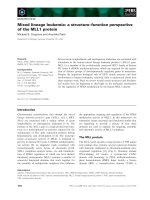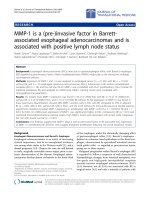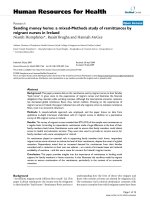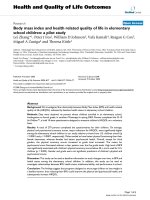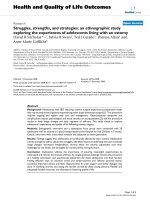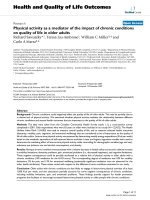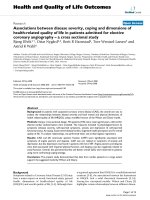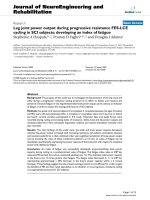báo cáo hóa học:" Acromioclavicular joint dislocation: a comparative biomechanical study of the palmaris-longus tendon graft reconstruction with other augmentative methods in cadaveric models" docx
Bạn đang xem bản rút gọn của tài liệu. Xem và tải ngay bản đầy đủ của tài liệu tại đây (604.77 KB, 10 trang )
BioMed Central
Page 1 of 10
(page number not for citation purposes)
Journal of Orthopaedic Surgery and
Research
Open Access
Research article
Acromioclavicular joint dislocation: a comparative biomechanical
study of the palmaris-longus tendon graft reconstruction with other
augmentative methods in cadaveric models
Guntur E Luis*, Chee-Khuen Yong, Deepak A Singh, S Sengupta and
David SK Choon
Address: Department of Orthopaedics Surgery, University of Malaya, Kuala Lumpur, Malaysia
Email: Guntur E Luis* - ; Chee-Khuen Yong - ; Deepak A Singh - ;
S Sengupta - ; David SK Choon -
* Corresponding author
Abstract
Background: Acromioclavicular injuries are common in sports medicine. Surgical intervention is
generally advocated for chronic instability of Rockwood grade III and more severe injuries. Various
methods of coracoclavicular ligament reconstruction and augmentation have been described. The
objective of this study is to compare the biomechanical properties of a novel palmaris-longus
tendon reconstruction with those of the native AC+CC ligaments, the modified Weaver-Dunn
reconstruction, the ACJ capsuloligamentous complex repair, screw and clavicle hook plate
augmentation.
Hypothesis: There is no difference, biomechanically, amongst the various reconstruction and
augmentative methods.
Study Design: Controlled laboratory cadaveric study.
Methods: 54 cadaveric native (acromioclavicular and coracoclavicular) ligaments were tested
using the Instron machine. Superior loading was performed in the 6 groups: 1) in the intact states,
2) after modified Weaver-Dunn reconstruction (WD), 3) after modified Weaver-Dunn
reconstruction with acromioclavicular joint capsuloligamentous repair (WD.ACJ), 4) after modified
Weaver-Dunn reconstruction with clavicular hook plate augmentation (WD.CP) or 5) after
modified Weaver-Dunn reconstruction with coracoclavicular screw augmentation (WD.BS) and 6)
after modified Weaver-Dunn reconstruction with mersilene tape-palmaris-longus tendon graft
reconstruction (WD. PLmt). Posterior-anterior (horizontal) loading was similarly performed in all
groups, except groups 4 and 5. The respective failure loads, stiffnesses, displacements at failure and
modes of failure were recorded. Data analysis was carried out using a one-way ANOVA, with
Student's unpaired t-test for unpaired data (S-PLUS statistical package 2005).
Results: Native ligaments were the strongest and stiffest when compared to other modes of
reconstruction and augmentation except coracoclavicular screw, in both posterior-anterior and
superior directions (p < 0.005).
WD.ACJ provided additional posterior-anterior (P = 0. 039) but not superior (p = 0.250) stability
when compared to WD alone.
Published: 27 November 2007
Journal of Orthopaedic Surgery and Research 2007, 2:22 doi:10.1186/1749-799X-2-22
Received: 11 February 2007
Accepted: 27 November 2007
This article is available from: />© 2007 Luis et al; licensee BioMed Central Ltd.
This is an Open Access article distributed under the terms of the Creative Commons Attribution License ( />),
which permits unrestricted use, distribution, and reproduction in any medium, provided the original work is properly cited.
Journal of Orthopaedic Surgery and Research 2007, 2:22 />Page 2 of 10
(page number not for citation purposes)
WD+PLmt, in loads and stiffness at failure superiorly, was similar to WD+CP (p = 0.066).
WD+PLmt, in loads and stiffness at failure postero-anteriorly, was similar to WD+ACJ (p = 0.084).
Superiorly, WD+CP had similar strength as WD+BS (p = 0.057), but it was less stiff (p < 0.005).
Conclusions and Clinical Relevance: Modified Weaver-Dunn procedure must always be
supplemented with acromioclavicular capsuloligamentous repair to increase posterior-anterior
stability. Palmaris-Longus tendon graft provides both additional superior and posterior-anterior
stability when used for acromioclavicular capsuloligamentous reconstruction. It is a good
alternative to clavicle hook plate in acromioclavicular dislocation.
Introduction
The acromioclavicular and coracoclavicular ligaments of
the shoulder joints are prone to sports injuries especially
in throwing athletes. The mechanism of injury usually
involves a direct trauma to the superior aspect of the
acromion and includes inferior and anterior translation of
the acromion in relation to the distal aspect of the clavicle.
Operative treatment has been advocated for certain type
III acromioclavicular joint separations and certainly in
types IV and V acromioclavicular joint injuries [1-
3,12,13,20]. Previous studies have demonstrated that the
acromioclavicular ligaments control anterior-posterior
stability, while the coracoclavicular ligaments control
superior-inferior stability [16,27].
The original Weaver and Dunn technique, first described
in 1972, did not include augmentation device [8,29].
Later studies showed results in favour of augmenting the
strength of the coracoacromial ligament transfer while it is
healing [6,10,14,15,22,25]. Current operative techniques
can be classified into 2 groups : 1) Those that focus on the
primary healing of the coracoclavicular ligaments, by
holding the clavicle and coracoid in a reduced position
and 2) those that focus on reconstructing the coracoclavic-
ular ligaments, using local tissue transfers or tendon
grafts. The former allows primary healing of the coracocla-
vicular ligament by either fixing the acromioclavicular
joints using K-wires, Steinman pins, tension banding, and
clavicle hook plates or fixing the coracoid to the clavicle
using screws, sutures, suture anchors, tapes and direct
suture of the coracoclavicular ligaments. These techniques
assume that the coracoclavicular ligaments will heal at its
near preinjury tensile strength. The latter transfers local
tissue sources to the clavicle or uses tendon grafts, either
autografts or allografts. One common problem with these
techniques remains the weak initial fixation of the liga-
ment or tendon to the clavicle.
There is an increasing trend in using tendon grafts for
reconstructing the coracoclavicular ligaments. We have
chosen a novel reconstruction technique for the acromio-
clavicular capsuloligamentous complex using the pal-
maris-longus tendon graft since the palmaris-longus
tendon is dispensable and can be harvested with low mor-
bidity. The objective of this study is to compare the bio-
mechanical properties of this novel palmaris-longus
tendon reconstruction with those of the native AC+CC lig-
aments, the modified Weaver-Dunn reconstruction, the
ACJ capsuloligamentous complex repair, screw and clavi-
cle hook plate augmentation.
Methods
Sampling
56 fresh frozen shoulders were obtained from unclaimed
bodies. Two shoulder specimens were excluded because of
gross comminuted scapula fractures. The ages of the spec-
imens ranged from 25 to 46 years old, with a mean of
35+/-11 years old. There were 27 right and 27 left shoul-
ders. There were 10 pairs of female and 17 pairs of male
shoulders. There was no gross pathology of the ligaments
or bones. None of the shoulders had been previously
operated on. The glenohumeral and sternoclavicular
joints were disarticulated. The shoulders were dissected
free of all skin, muscle and subcutaneous tissues. The clav-
icles and scapulae were exposed, carefully preserving the
acromioclavicular (ACL) and coracoclavicular (CCL) liga-
ments. No prior sectioning of these ligaments was done to
allow accurate simulation of the non-selective nature of
clinical ligament injury.
The coracoacromial ligaments were resected at its inser-
tion on the undersurface of the acromion, prior to testing.
This removes any confounding effects since the coracoac-
romial ligaments, often blending in with the inferior
acromioclavicular ligaments, may exert an inferior
restraining force. No distal clavicle end resection was per-
formed. The specimens were stored at -20 deg. Before the
day of the test, each shoulder specimen was thawed over-
night at room temperature.
The 54 grossly normal fresh frozen shoulders were tensile
tested to failure, using the Instron Machine Model 8846,
to compare the structural properties of the i) combined
native acromioclavicular and coracoclavicular ligaments,
ii) the coracoacromial ligament transfer in modified
Weaver-Dunn reconstruction, iii) efmodified Weaver-
Journal of Orthopaedic Surgery and Research 2007, 2:22 />Page 3 of 10
(page number not for citation purposes)
Dunn reconstruction with the acromioclavicular capsulo-
ligamentous repair, iv) modified Weaver-Dunn recon-
struction with the coracoclavicular screw augmentation,
v) modified Weaver-Dunn reconstruction with clavicle
hook plate augmentation and vi) modified Weaver-Dunn
reconstruction with ACJ reconstruction using palmaris-
longus tendon graft and mersilene tape augmentation. At
a crosshead speed of 50 mm per min, the specimens were
tested for superior and anterior displacements. This low
crosshead speed used because failure occurs at both a
higher load and greater extension if the test is done at high
speed, which means that more energy is needed to rupture
the specimen at high speed. Stiffening effect of the liga-
ments could also be minimized at this low rate. Preten-
sioning was performed at 70 N (physiological load) to
reduce the "crimp" effect of the ligaments to straighten the
collagen fibres.
The acromioclavicular joint is a true diarthrodial joint
formed by the articular surfaces of the outer end of the
clavicle and of the acromion. The clavicle and acromion
are united by a capsule inserting a few millimeters from
the articulating surfaces. This loose capsule is reinforced
on the superior and inferior aspect by the powerful
acromioclavicular ligament which runs transversely over
the joint. The superior component is much better devel-
oped and thicker than the inferior acromioclavicular liga-
ment. A resultant force causing ligament failure can be
resolved into 3 vectors in the x, y and z axes. The magni-
tude of a force required to disrupt the abovementioned
transverse fibres is the least when applied in a direction
perpendicular to the direction of these fibres, as compared
to when the force is directed parallel to the direction of
these fibres.
The setup of the test rig (Fig. 1), was therefore designed to
apply these perpendicular forces to the fibres, in the supe-
rior and anterior directions (2 axes). These forces were the
most common disruptive forces in injuries. The 3
rd
axis
(distractive force parallel to the direction of the fibres and
long axis of the clavicle) subjecting the AC joint to distrac-
tive force is not tested since it is uncommon. The anatom-
ical position was defined by aligning the bony articulation
of the distal end of the clavicle and the acromion process,
with equal tensioning throughout the soft tissue struc-
tures. Custom-made clamps were used to mount the clav-
icle to the crosshead and the scapula to the base of the
Instron machine such that a load as perpendicular as pos-
sible can be applied. The long axis of the clavicle and the
scapular plane were oriented at approximately 90 degrees
to one another. To ensure that the coracoclavicular liga-
ment complex is centered under the crosshead, one clamp
is placed medially to the CC ligament, while the other is
placed in between the CC and AC ligament complexes.
This testing setup assumed that in an ACJ dislocation
injury, there was no movement in the sternoclavicular
joint (ie, the clavicle and sternum acted as one unit). The
values for loads to failure, obtained for this study, were
thus the least forces required for ACJ dislocation in the
particular direction of interest.
The acromial reference point was defined as the centroid
of its surface. With the aid of a proportional divider, the
medial boundary of the acromion was determined. The
two most anteromedial and posteromedial points of the
acromion were then established. A line A, connecting
these two points, was drawn and its length measured
using a caliper. Line B, with length b, was constructed per-
pendicularly from line A to the medical concave aspect of
the acromion. The medial concave aspect of the
acromion, articulating with the lateral end of the clavicle,
most closely approximated the arc of a semi-ellipse. The
centroid of acromion, coordinate (X, Y), was thus outside
the acromion. The midpoint of line A was taken as the
mean of all X of the acromion. The mean of all Y for the
acromion was described by the formula 4b/(3 × 3.14). If
the distance b is zero, then the acromion was in total con-
tact with the lateral end of the clavicle. [See Additional file
1]
The distal clavicular reference point was defined as the
point on the clavicle in contact with the acromial refer-
ence point in the intact, unloaded joint. The joint separa-
tion, in response to a known applied load, was
determined along 2 axes. The posterior-anterior displace-
ment was defined as the distance between the point of
maximum anterior displacement of the clavicle reference
point and the neutral position of the clavicle reference
point (corresponding to the application of the 100-N
Test Rig SetupFigure 1
Test Rig Setup.
Journal of Orthopaedic Surgery and Research 2007, 2:22 />Page 4 of 10
(page number not for citation purposes)
force anteriorly). The superior displacement was defined
as the distance between the point of maximum superior
displacement of the clavicle reference point and the neu-
tral position of the clavicle reference point.
Increasing load was then applied to each specimen until
the testing endpoint was achieved, that is complete tear of
ACJ and ligament, complete failure of ligament recon-
struction or complete failure of reconstruction-augmenta-
tion construct and specimen failure. Superior
displacement in the coronal plane and anterior displace-
ment in the sagittal plane were determined by measuring
joint separation as the clavicle was loaded in the superior
and anterior directions respectively. There was no move-
ment between the clamps and specimens during testing.
The movement from the AC joint was equal to the dis-
placement of the load cell and recorded simultaneously
by the Instron machine software, as the loads were being
generated. Parallel reference indicators (linear frames
with accuracy to 0.1 cm) attached to either side of the load
cell also allows measurement of separation, with error of
+/- 6%. The respective failure loads, displacement at fail-
ure, stiffness and modes of failure were recorded. When
"failure" status was reached, the load-cell returned the
clavicle to its original pre-tensioned resting position, with
respect to the acromion, as preset in the software program.
Unless a fracture or deformation occurred, the same scap-
ula and clavicle was used for each of the subsequent
reconstructions.
The order of testing sequence was not randomized and
executed in the following manner:
Testing Sequence
(1) Superior Loading.
Native Lig → WD → End Point (38 Specimens).
→ WD + ACJ → End Point (9 Specimens).
→ WD + CP → End Point (10 Specimens).
→ WD + BS → End Point (10 Specimens).
→ WD + PL-MT → End Point (9 Specimens).
(2) Posterior-Anterior Loading.
Native Lig → WD → End Point (16 Specimens).
→ WD + ACJ → End Point (8 Specimens).
→ WD + PL-MT → End Point (8 Specimens).
("→ " implies tested to failure)
Reconstruction and Augmentation Techniques
• Modified Weaver-Dunn reconstruction.
The modified Weaver-Dunn reconstruction (Fig 2) was
performed by dividing the coracoacromial ligament at its
acromial insertion. The freed acromial end of the cora-
coacromial ligament was anchored with whipstick sutures
using No.2 Ethibond sutures (Johnson and Johnson).
Prior templating of the future 3.5 mm drill-hole sites was
made with the clavicle hook plate sitting on the superior
aspect of the clavicle. The stump of the coracoacromial lig-
ament was drawn into one of the middle drill-holes
through the inferior cortex and out of the superior cortex
of the clavicle. The sutures were then tied around the ante-
rior half of the clavicle. Repair of the acromioclavicular
capsuloligamentous complex was performed using Bun-
nell-type weave with No. 2 Ethibond suture. The distal
ends of the clavicles were not resected to allow for repair
of the acromioclavicular capsuloligamentous complex
and optimal plate sitting on the clavicle.
• ACJ capsuloligamentous repair.
The acromioclavicular capsuloligamentous complex
using a Bunnell-type weave with No 2 Ethibond sutures.
• Clavicle hook plate augmentation.
The acromioclavicular joint was reduced under vision.
The clavicle hook plates, (Fig 3), with 6 or 8 holes, are pre-
contoured in left and right plates. They are available in
commercially pure titanium and stainless steel. The hook
of the plate (Synthes) with a 15 mm or 18 mm hook
Modified Weaver-Dunn reconstructionFigure 2
Modified Weaver-Dunn reconstruction.
Journal of Orthopaedic Surgery and Research 2007, 2:22 />Page 5 of 10
(page number not for citation purposes)
depth was first passed under the acromion, then on the
superior aspect of the clavicle. Finally, 3.5 mm cortical
screws were placed in the medial and anterolateral screw
holes. The coracoacromial ligament graft can be tunneled
into one of the middle screw holes of the plate. The plate
with 18 mm hook depth is used instead if there is diffi-
culty lowering the plate shaft onto the clavicle.
Its use is especially advantageous in situations where con-
comitant coracoid process fracture precludes the use of
bioabsorbable tape slings or coracoclavicular screw fixa-
tion.
• Coracoclavicular screw augmentation (Fig 4).
A modification of the method described originally by Bos-
worth was performed. [2] The AO cortical screw (Synthes)
was positioned starting from the posterior part of the clav-
icle 4 cm from its lateral end and passing forward and
downward to be inserted into the base of the coracoid
process. A 4.5 mm hole was first drilled in the clavicle and
then a 3.2 mm drill, passing through this hole, advanced
into the base of the coracoid. A 4.5 mm AO screw of ade-
quate length, with a large washer, was now inserted
through the hole and screwed into the coracoid until the
clavicle was compressed onto the coracoid. Bicortical fix-
ation was achieved, with the inferior cortex being
breached by 2 threads of the screw.
• Palmaris Longus tendon – Mersilene tape augmentation
(Fig 5).
Palmaris Longus tendon grafts were prepared after being
harvested from the volar aspect of cadaveric forearms via
two 1-cm transverse mid-axial incisions spaced about 10
cm apart. Prior to testing, a tendon graft was then passed
through the 3.2 mm holes, each drilled at the distal end of
the clavicle and at the acromion, 1 cm away from the
acromioclavicular joint with the ends secured in a pulver-
taft fashion, using No.2 Ethibond sutures, This recon-
struction was reinforced with a Mersilene tape which was
passed beneath the coracoid process, swung and tied on
the superior aspect of the distal third of the clavicle.
Load-displacement values were analyzed for each test to
determine structural properties, that is, load to failure (in
newtons), stiffness (in newtons per millimeter) and dis-
placement at failure load (in millimeters). The load to
failure and displacement at failure represents the load and
point at which the native ligaments fail completely. These
Palmaris-Longus tendon reconstruction – Mersilene tape augmentationFigure 5
Palmaris-Longus tendon reconstruction – Mersilene tape
augmentation.
Clavicle hook plate augmentationFigure 3
Clavicle hook plate augmentation.
Coracoclavicular Screw augmentationFigure 4
Coracoclavicular Screw augmentation.
Journal of Orthopaedic Surgery and Research 2007, 2:22 />Page 6 of 10
(page number not for citation purposes)
results were recorded directly from the computer. The lin-
ear stiffness was calculated by determining the slope of the
line fit to the linear portion of the load-elongation curve.
Load-displacement values were plotted simultaneously.
These results for the clavicle hook plate more accurately
reflect the load at which the distal clavicle end fractures or
acromion fractures or when the hook dislodges from the
inferior surface of the acromion.
Statistical Analysis
A one-way analysis of variance was used for multiple com-
parisons amongst the 5 groups, with respect to load to
failure, displacement at failure and tensile stiffness. (S-
PLUS statistical software 2005). The Student's paired t-test
was used only for comparison between sequential testing
of native ligaments and WD reconstruction in the same
specimen. Unpaired specimens were analyzed using Stu-
dent's unpaired t-test. A p-value of 0.05 was used to
denote the level of significance.
Results
The loads at failure, stiffness, displacement and modes of
failure for the intact ligaments and various reconstructive
methods, in the superior and posterior-anterior loadings,
are summarized in Table 1. The results are expressed in
(Mean +/- S.E.) and (Lower and upper confidence limits –
LCL, UCL) [See Additional File 2 for Boxplots 1 to 6].
Load at Failure
In superior loading (Boxplot 1), the tensile strength was
greatest for the native ligaments when compared to other
reconstruction/augmentation (p < 0.01), but it was not
significantly different from WD+BS (p = 0.10). There was,
however, no significant difference in tensile strength
between WD and WD.ACJ reconstruction (p = 0.26). WD-
PLmt was found not to be significantly different from
WD.CP (p = 0.23). WD.CP was also not significantly dif-
ferent from WD.BS in tensile strength (p = 0.06) but sig-
nificantly stronger than WD.ACJ (p < 0.01).
In posterior-anterior loading (Boxplot 2), the native liga-
ments were the strongest (p < 0.01) while the WD was the
weakest amongst the comparison groups (p < 0.05). Con-
trary to superior loading, WD.ACJ in posterior-anterior
loading was significantly stronger than WD (p = 0.04).
There was no significant difference in tensile strength
between WD.ACJ and WD.PLmt (p = 0.26).
Stiffness at Failure
In superior loading (Boxplot 3), the native ligaments were
significantly less stiff than WD.BS (p = 0.03) but signifi-
cantly stiffer than other reconstructions (p < 0.001). The
WD is the least stiff (p < 0.01). No significant difference in
stiffness was observed between WD.CP and WD.PLmt (p
= 0.07). WD.ACJ was also not significantly stiffer than
WD.PLmt (p = 0.75).
In posterior-anterior loading (Boxplot 4), the native liga-
ments were significantly stiffer than WD and WD.PLmt (p
< 0.05). However, there is no significant difference
between the native ligaments and WD.ACJ (p = 0.25).
WD.ACJ and WD.PLmt were both significantly stiffer than
WD alone (p < 0.05). However there was no statistical dif-
ference in stiffness between WD.ACJ and WD.PLmt (p =
0.08).
Table 1: Comparison of the biomechanical characteristics of the intact ligaments, various reconstruction and augmentation methods
Characteristic Native WD WD.ACJ WD.BS WD.CP WD.PLmt
Failure Loads (Superior) (kN) .801+/ 076 .118+/ 023 .161+/ 019 .573+/ 088 .397+/ 046 .276+/ 046
(LCL, UCL) (.648, .954) (.071, .166) (.119, .204) (.385, .760) (.304, .490) (.168, .384)
Failure Loads (P-A) (kN) .746+/ 089 .103+/ 015 .278+/ 074 .188+/ 017
(LCL, UCL) (.529, .963) (.067, .139) (.097, .459) (.148, .229)
Stiffness (Superior) (kN/mm) .079+/ 009 .006+/ 000 .015+/ 001) .121+/ 016 .025+/ 003 .016+/ 002
(LCL, UCL) (.059, .100) (.005, .008) (.012, .018) (.084,.157) (.017, .032) (.010, .021)
Stiffness (P-A) (kN/mm) .022+/ 004 .004+/ 000 .042+/ 016 .012+/ 000
(LCL, UCL) (.012, .031) (.002, .005) (.003,.080) (.010, .013)
Displacement (Superior) (mm) 25.25+/-1.77 28.70+/-1.93 29.43+/-2.63 21.92+/-4.11 26.61+/-1.26 31.16+/-3.45
(LCL, UCL) (21.70, 28.81) (24.73, 32.67) (23.67, 35.16) (13.06, 13.80) (24.05,29.18) (23.02, 39.31)
Displacement (P-A) (mm) 56.36+/-9.80 43.05+/-5.46 38.65+/-7.48 41.46+/-4.63
(LCL, UCL) (32.38, 80.33) (29.69, 56.40) (20.343, 56.95) (30.14, 52.77)
Failure Modes Midsubstance Suture failure Suture pullout Screw pullout clavicle suture
tear 90% at knot-clavicle 90% 100% fracture 70% breakage 10%
Ligament insertion site interface breakage acromion knot
failure 10% 100% 10% fracture 30% breakage 90%
(LCL, UCL)-lower and upper
confidence limit
Journal of Orthopaedic Surgery and Research 2007, 2:22 />Page 7 of 10
(page number not for citation purposes)
Displacement at Failure
In both superior (Boxplot 5) and posterior-anterior (Box-
plot 6) loading, there was no significant difference
amongst all the comparison groups. (p > 0.05)
Modes of Failure
The native ligaments failed at midsubstance (90%) and at
the ligament insertion site (10%). In coracoacromial liga-
ment transfer, all sutures failed at knot-clavicle interface.
Suture pull-out (90%) and breakage (10%) were observed
for WD.ACJ reconstruction. All coracoclavicular screws
failed by screw pull-out. WD.PLmt reconstruction failed
by suture (10%) or knot breakage (90%).
Most of clavicle hook plate failures occurred at 3 sites: 1)
acromion fractures which occurs within 20 mm of the
acromion tip, 2) distal clavicle fractures which occured at
the site of the anterolateral screw holes of the clavicle
hook plate and 3) the gradual deformation of the
acromion in the superior direction allowed the hook of
the plate to bend and slip superiorly, especially when the
lateral ends of the plate have not been pre-contoured.
There were no coracoid fractures as reported by Costic et
al. [5].
Discussion
This is the first study looking at the reconstruction of the
acromioclavicular capsuloligamentous complex using the
palmaris longus tendon graft. Biomechanical testing
showed that in superior loading, it is as strong in tensile
strength and as stiff as the clavicle hook plate in providing
superior stability. In posterior-anterior loading, it is as
strong and stiff as the ACJ capsuloligamentous repair.
Our study looks at the combined effect of native acromio-
clavicular and coracoclavicular ligaments, in contrast to
other studies [9,17,24,26], which more closely resemble
clinical situations where impact forces do not selectively
damage either of these ligaments. A combined injury of
both these ligaments is required to give a Rockwood type
III or more severe ACJ dislocation. Double-bundle recon-
stitution of the conoid and trapezoid ligaments in Maz-
zocca's study is innovative[21], however, AC
capsuloligametous repair was not mentioned and testing
in the posterior-anterior direction was not performed. In
this study, we have shown the pivotal role of the AC cap-
suloligamentous complex in providing posterior-anterior
stability; however, superior stability is provided by either
plate or screw augmentation or tendon graft reconstruc-
tion. Debski et al also showed that the ACJ capsule confers
posterior-anterior stability and the intact coracoclavicular
ligament cannot compensate for loss of capsular function
during posterior-anterior loading. Failure to augment a
coracoclavicular reconstruction will subject the latter to
higher risk of failure. Any residual posterior-anterior
instability can cause postoperative pain [6].
Weaver-Dunn reconstruction alone with coracoacromial
ligament is insufficient. Incomplete reduction or recur-
rence of dislocation was reported to be as high as 24%
[27]. We found its strength to be one-eighth that of the
native combined AC+CC ligaments (801 +/- 75) N. Harris
et al reported its strength to be one-quarter that of CC lig-
aments (500+/-134) N alone. Various augmentation
methods have been described. [14] Although none of the
augmentative methods tested restored acromioclavicular
stability to normal, all proved superior to the Weaver-
Dunn reconstruction alone [7]. In addition, Deshmukh et
al showed that, the contribution of Weaver-Dunn transfer
to the stability, when combined with augmentative fixa-
tion, is negligible at time zero. This further justifies for the
need for augmentation.
We found that both BS and clavicle hook plate devices
provide adequate augmentation. BS provided 70% and
170% of the tensile strength and stiffness of the native lig-
aments, respectively. On the other hand, clavicle hook
plate provided 50% and 30% of the tensile strength and
stiffness of the native ligaments, respectively. The results
of BS augmentation are consistent with that reported by
Motamedi et al. [22]. Urist found that failure strength,
however, was reduced by half if only unicortical purchase
was obtained, indicating the importance of accurate screw
placement [27]. Disadvantages of this screw fixation tech-
nique include complications during screw insertion,
screw irritation, infection, pullout and breakage [14].
Early deformity recurrence may occur with early implant
removal.
An ideal augmentation device should, biomechanically,
have a similar compliance as that of native ligaments. Too
stiff a device can predispose to bone breakage and cause
joint stiffness ex vivo, whilst too compliant a device can
cause premature failure of the Weaver-Dunn construct
during rehabilitation. Distal clavicle resection as part of
Weaver-Dunn reconstruction, described by Mumford, was
thought to prevent postoperative pain and osteolysis [23].
This was shown not to be the case by Browne JE [3]. We
found that distal clavisectomy precludes ACJ repair and
prevents proper seating of the clavicle hook plate.
Several considerations need to be made when using the
clavicle hook plate. Further prebending of the plate may
be required to allow optimal sitting on the clavicle. The
narrow rectangular-shaped clavicle hook under the
acromion surface causes tremendous contact stress and
predisposes to acromial fracture during loading. A more
rounded disk-shaped anchorage will be ideal. Extreme
care must be exercised during the drilling of the anterola-
Journal of Orthopaedic Surgery and Research 2007, 2:22 />Page 8 of 10
(page number not for citation purposes)
teral distal holes since stress fractures have occurred at
these sites. Insertion of medial screws may be sufficient.
Distal resection of the distal clavicle or the use of autoge-
nous grafts such as semitendinosus or palmaris longus
graft for the reconstruction of the acromioclavicular cap-
suloligamentous complex will preclude the use of clavicle
hook plates because of inadequate sitting of the implant
on the clavicle. A further consideration ex vivo is that of
subacromial impingement which will need to be explored
in post-operative patients. The need for implant removal
following graft incorporation, as with the coracoclavicular
screw fixation, is a disadvantage compared to autologous
grafts or biodegradable substances such as Mersilene
tapes. The current clavicle hook plate does not address
posterior-anterior instability and translation of the acro-
moclavicular joint. A routine repair or reconstruction of
the acromioclavicular joint capsuloligamentous complex
can address this problem.
Coracoclavicular ligament reconstruction using tendon
grafts have been widely described. There are the advan-
tages of biological integration, no fracture or loosening,
no need for implant removal and low morbidity with graft
harvesting.
In this study, we used the palmaris longus tendon graft, in
addition to the Weaver-Dunn procedure, to reconstruct
the acromioclavicular capsuloligamentous complex and
augmented it with a 5 mm Mersilene tape which looped
around the coracoid process and clavicle. The tendon graft
may benefit from augmentation with the tape to protect
the repair, limit the amount of possible stretching and
counteract the weakening effects of revascularization. This
reconstruction had tensile strength not significantly differ-
ent from the clavicle hook plate with superior loading and
similar to ACJ capsuloligamentous repair with posterior-
anterior loading. We also noticed that its flat cross-sec-
tional area, superior-inferiorly, also helped in its sitting
across the acromioclavicular joint. It therefore served a
dual function of stabilizing the acromioclavicular joint in
both the posterior-anterior and superior directions while
protecting the concurrent WD reconstruction. The pal-
maris longus tendon grafts used here for ACJ ligament
reconstruction were about 10 cm long, as opposed to the
16 cm palmaris longus graft used by Lee et al for coraco-
clavicular ligament reconstruction [19].
Grutter and Petersen showed that, when tested in coronal
plane only, the Weaver-Dunn reconstruction, palmaris-
longus tendon graft and flexor carpi radialis graft achieve
tensile strength 59%, 40% and 95% that of the native ACJ
capsule [12]. These were in contrast to our findings, with
the WD and palmaris longus reconstruction achieving, in
the coronal plane, 14.7% and 34% that of the combined
native ligaments and in the sagittal plane, 8% and 19.6%
that of the combined native ligaments. The discrepancy in
results arose because Grutter et al compared the tensile
strength of the reconstruction with that of the native ACJ
capsule only (simulating grade II and below injury)
whereas we compared the tensile strength of our recon-
struction with that of the combined native AC + CC liga-
ments (simulating grade III and above injury).
Suture failures were noted in WD reconstruction, ACJ
repair and PL-mt reconstruction. This was not surprising
given the fact that the sutures were weaker in tensile
strength compared to that of the CAL, ACL or palmaris
longus ligament, as shown by Harris et al. [17] and Lee et
al. [21]. Native ligaments failed at mid-substance at the
low strain rate used in our study. However, most speci-
mens will have bony avulsion if high strain rates are used.
Therefore, the crosshead speed or strain rate must be spec-
ified to suit the purpose of one's study. For clavicle hook
plates testing, the probability of a clavicle fracture is
dependent on the bone size and amount of bone bridge
in between drill holes. On the other hand, a strong fixa-
tion on the clavicle will result in plate failure by acromial
deformation or fracture.
The strengths of the current study were observed. Firstly,
baseline tensile strength results of the native ligaments
were made available for comparison with other recon-
structive and augmentative groups, in both coronal and
sagittal planes. Secondly, the testing setup has 3 degrees of
freedom and allows firm hold on the scapular blade and
proximal clavicle. It allows plastic bending of the
acromion, coracoid process and distal clavicle, which fur-
ther simulates a real-event injury. In-situ precise testing of
native ligaments and sequential repair or augmentation
were performed without removing the specimens from
the testing apparatus [18,19]. Thirdly, the methods used
to measure failure load and failure displacement for each
group were precise, objective and reproducible. Loads to
failure were consistently applied in both coronal and sag-
ittal directions for various conditions tested in each spec-
imen because the specimens were not removed from the
test rig when the reconstruction or augmentation proce-
dures were performed. Fourthly, reconstructive and aug-
mentative procedures were performed in conjunction
with the modified Weaver-Dunn procedure and finally,
the failure loads of the native ligaments were measured in
comparison with the capsuloligamentous reconstruction
and the various augmentative repairs. The palmaris-lon-
gus tendon graft-mersilene tape graft was tested uniquely
in reconstructing the ACJ, in contrast to other studies
where it was used to reconstruct the CC ligament.
Concurrently, a few limitations of this study were also
seen. Firstly, tensile loading was performed only in the
superior axis at a much lower strain rate than that which
Journal of Orthopaedic Surgery and Research 2007, 2:22 />Page 9 of 10
(page number not for citation purposes)
would have occurred during injury. Secondly, repetitive
testing on a bony specimen may cause plastic deforma-
tion of the clavicle and acromion and predispose to bony
failure in some specimens; conversely, the ligament repair
and reconstruction were performed on uninjured joints
and did not account for any damage to the coracoid or
clavicle which may accompany the injury. Thirdly, the
cyclic and static viscoelastic properties of the native liga-
ments and fatigue properties of the clavicle hook plate
and coracoclavicular screw, have not been determined.
Finally, it has been shown that all of the soft tissues at the
acromioclavicular joint function synergistically, in a com-
plex manner, to provide joint stability. Thus, traumatic
disruption of the acromioclavicular joint capsule is
thought to result in abnormal joint kinematics and load
transmission, factors that increase the possibility of
postinjury pain, instability, and degenerative joint dis-
ease. These are factors which could not be tested in this
study [8,27].
Conclusion
Modified Weaver-Dunn procedure must always be sup-
plemented with acromioclavicular capsuloligamentous
repair to increase posterior-anterior stability. Palmaris-
Longus tendon graft provides both additional superior
and posterior-anterior stability when used for acromiocla-
vicular capsuloligamentous reconstruction. It is therefore
a good alternative to clavicle hook plate in acromioclavic-
ular injuries.
Authors' contributions
GEL dissected the specimens, designed the methodology,
conducted the experiments, performed the statistical anal-
ysis and drafted the manuscript.
CKY was involved in the conception, participated in the
coordination of the study and data analysis.
DAS and SS were involved in the critical revision of the
manuscript.
DSK was involved in conceptual input to the study.
All authors read and approved the final manuscript.
Additional material
Acknowledgements
We would like to thank the Department of Mechanical Engineering, Univer-
sity of Malaya, for the manufacture of the custom-made clamps and techni-
cal assistance with the Instron machine.
We would also like to thank Synthes, Malaysia for providing the clavicle
hook plates for this study.
No funding has been received for this study. There is no conflict of interest.
References
1. Bargren JH, Erlanger S, Dick HM: Biomechanics and comparison
of two operative methods of treatment of complete acromi-
oclavicular separation. Clin Orthop 1978, 130:267-272.
2. Bosworth BM: Acromioclavicular separation. A new method
of repair. Surg Gynecol Obstet 1941, 73:866-871.
3. Browne JE: Acromioclavicular joint dislocations. Comparative
results following operative treatment with and without clavi-
sectomy. Am J Sports Med 1977, 5:258-263.
4. Cadenat FM: The treatment of dislocations and fractures of
the outer end of the clavicle. Int Clin 1917, 27:145-69.
5. Costic R, Labriola J, Rodosky M, et al.: Biomechanical rationale
for development of anatomical reconstructions of coracocla-
vicular ligaments after complete acromioclavicular joint dis-
locations. Am J Sports Med 2004, 32:1929-1936.
6. Crowinshield RD, Pope MH: The strength and failure rat medial
collateral ligament. Journal of Trauma 1976, 16(2):99-125.
7. Debski RE, Parsons IM, Woo Savio L-Y, Fu Freddie H: Effect of cap-
sular injury on acromioclavicular joint mechanics. JBJS(Ameri-
can Volume) 2001, 83(9):1344-52.
8. Deshmukh AV, Wilson D, Zilberfarb J, et al.: Stability of acromio-
clavicular joint reconstruction-Biomechanical testing of var-
ious surgical techniques in a cadaveric Model. Am J Sports Med
2004, 32:1492-1498.
9. Dorlot, et al.: Load elongation behavior of canine anterior cru-
ciate ligament. J Biomech Eng 1980, 102:190-193.
10. Dumontier C, Sautet A, Man M: Acromioclavicular dislocations:
treatment by coracoacromial ligamentoplasty. J Shoulder
Elbow Surg 1995, 4:130-134.
11. Flatow EL: The biomechanics of the acromioclavicular, ster-
noclavicular, and scapulothoracic joints. Instr Course Lect 1993,
42:237-45.
12. Fukuda K, Craig E, An KN, Cofield RH, Chao EY: Biomechanical
study of the ligamentous system of the acromioclavicular
joint. J Bone Joint Surg Am 1986, 68(3):434-440.
13. Galpin RD, Hawkins RJ, Grainger RW: A comparative analysis of
operative versus nonoperative treatment of grade III
acromioclavicular separations. Clin Orthop 1985, 193:150-155.
14. Grana WA, Egle DM, Mahnkan R, et al.: An analysis of autograft
fixation after anterior cruciate ligament reconstruction in a
rabbit model. Am J Sports Med 1994, 22:344-351.
15. Grutter PW, Petersen SA: Anatomical ACJ reconstruction: A
biomechanical comparison of reconstructive techniques of
acromioclavicular joint reconstruction. Am J Sports Med 2005,
33:1723.
16. Guy DK, Wirth MA, Griffin JL, et al.: Reconstruction of chronic
and complete dislocations of the acromioclavicular joint. Clin
Orthop 1998, 347:138-149.
Additional file 1
Graph showing the centroid of the acromion.
Click here for file
[ />799X-2-22-S1.doc]
Additional file 2
Boxplots showing results of loads, stiffnesses and displacements at failure,
in the superior and posterior-anterior directions of the various augmenta-
tive and reconstructive methods.
Click here for file
[ />799X-2-22-S2.doc]
Publish with BioMed Central and every
scientist can read your work free of charge
"BioMed Central will be the most significant development for
disseminating the results of biomedical research in our lifetime."
Sir Paul Nurse, Cancer Research UK
Your research papers will be:
available free of charge to the entire biomedical community
peer reviewed and published immediately upon acceptance
cited in PubMed and archived on PubMed Central
yours — you keep the copyright
Submit your manuscript here:
/>BioMedcentral
Journal of Orthopaedic Surgery and Research 2007, 2:22 />Page 10 of 10
(page number not for citation purposes)
17. Harris R, Wallace A, Harper G, et al.: Structural properties of the
intact and the reconstructed coracoclavicular complex. Am J
Sports Med 2000, 28:103-108.
18. Hessmann M, Gotzen L, Gehling H: Acromioclavicular recon-
struction augmented with polydioxanonsulphate bands: sur-
gical technique and results. Am J Sports Med 1995, 23:552-556.
19. Klimkiewicz JJ, Williams GR, Sher JS, et al.: The acromioclavicular
capsule as a restraint to posterior translation of the clavicle:
a biomechanical analysis. J Shoulder Elbow Surg 1999, 8:119-24.
20. Lancaster S, Horowitz M, Alonso J: Complete acromioclavicular
separations: a comparison of operative methods. Clin Orthop
1987, 216:80-88.
21. Lee KW, Debski RE, Chen CH, et al.: Functional evaluation of the
ligaments at the acroimioclavicular joint during anteropos-
terior and superoinferior translation. Am J Sports Med 1997,
25:858-862.
22. Lee SJ, Nicholas SJ, Akizuki KH, McHugh MP, Kremenic IJ, Ben-Avi S,
et al.: Reconstruction of the coracoclavicular ligaments with
tendon grafts: a comparative biomechanical study. Am J Sports
Medicine 2003, 31(5):648-659.
23. Lemos M: The evaluation and treatment of the injured
acromioclavicular joint in athletes. Am J Sports Med 1998,
26:137-144.
24. Magen HE, et al.: Structural properties of 6 tibial fixation meth-
ods for ACL soft tissue grafts. Am J Sports Med 1999, 27:35-43.
25. Mazzocca AD, Santangelo SA, Johnson ST, Rios CG, Dumonski ML,
Arciero RA: A biomechanical evaluation of an anatomical
coracoclavicular ligament reconstruction. Am J Sports Med
2006, 34(2):236-246.
26. Motamedi A, Blevins F, Willis M, et al.: Biomechanics in the cora-
coclavicular ligament complex and augmentations used in its
repair and reconstruction. Am J Sports Med 2000, 28:380-385.
27. Mumford EB: Acromioclavicular dislocation. J Bone Joint Surg Am
1941, 23:799-802.
28. Neviaser JS: Acromioclavicular dislocation treated by trans-
ference of the coraco-acromial ligament. a long-term follow-
up in a series of 112 cases. Clin Orthop 1968, 58:57-68.
29. Nordin M, Frankel VH: Basic Biomechanics of the Musculoskel-
etal System. 2nd edition. Lea & Febiger; 1980.
30. Noyes FR, et al.: Biomechanics of ACL failure: an analysis of
strain-rate sensitivity and mechanism of failure in primates.
J Bone Joint Surg 1974, 56(2):236-253.
31. Noyes FR, et al.: The strength of the anterior cruciate ligament
in humans and rhesus monkeys. J Bone Joint Surg 1976,
58:1074-1082.
32. Rockwood CA Jr, Williams GR, Young DC: Injuries to the acromi-
oclavicular joint. In Rockwood and Green's fractures in adults Volume
2. 4th edition. Edited by: Rockwood CA Jr, Green DP Bucholz RW,
Heckman JD. Philadelphia: JB Lippincott Raven; 1996:1341-1413.
33. Rodeo SA, Arnoczky SP, Torzilli PA, Hidaka C, Warren RF: Tendon-
healing in a bone tunnel. A biomechanical and histological
study in the dog. J Bone Joint Surg Am 1993, 75(12):1795-1803.
34. Salter EG, Nasca RC, Shelly BS, et al.: Anatomical observations on
the acromioclavicular joint and supporting ligaments. Am J
Sports Medicine 1987, 15:199-206.
35. Ticker JB, et al.: Inferior glenohumeral ligament geometric and
strain-rate dependent properties. J Shoulder and Elbow Surg
1996, 5(4):269-279.
36. Urist MR: Complete dislocations of the acromioclavicular
joint. The nature of the traumatic lesion and effective meth-
ods of treatment with an analysis of forty-one cases.
J Bone
Joint Surg 1946, 28:813-37.
37. Wamis Singhatat , et al.: How four weeks of implantation affect
the strength and stiffness of a tendon graft in bone tunnel: a
study of 2 fixation devices in an extraarticular model in
ovine. Am J Sports Med 2002, 30(4):506-512.
38. Weaver J, Dunn H: Treatment of acromioclavicular injuries,
especially complete acromioclavicular separation. J Bone Joint
Surg Am 1972, 54:1187-1194.
39. Weiler A, et al.: Hamstring tendon fixation using interference
screws: A biomechanical study in calf tibial bone. Arthroscopy
1998, 14:29-37.
40. Weinstein D, McCann P, McIllveen S: Surgical treatment of com-
plete acromioclavicular dislocations. Am J Sports Med 1995,
23:324-331.
41. Woo SL, et al.: Effect of knee flexion on structural properties
of rabbit femur-ACL-tibia complex. Journal of Biomechanics
1987, 20:557-563.
42. Woo SL, et al.: The effect of strain rate on properties of the
medial collateral ligament in skeletal immature and mature
rabbits: a biomechanical and histological study. J of Orthop
Research 1990, 8:712-721.
43. Woo SL, Debski RE, Withow JB: Biomechanics of Knee Liga-
ments. Am J Sports Med 1999, 27(4):533-543.
